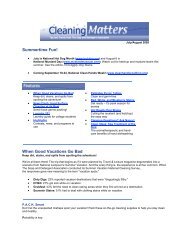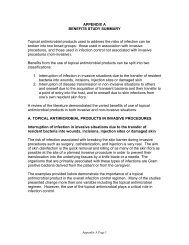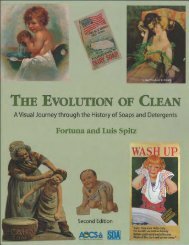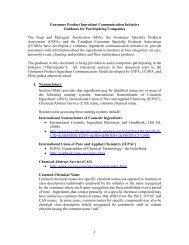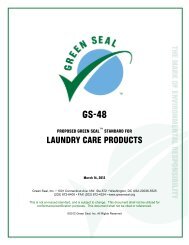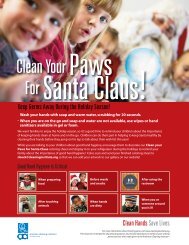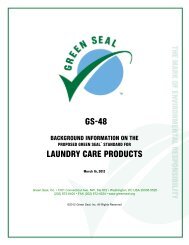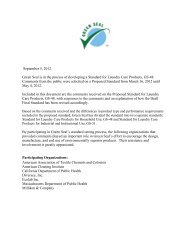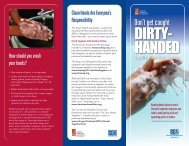subchapter c -- federal hazardous substances act regulations
subchapter c -- federal hazardous substances act regulations
subchapter c -- federal hazardous substances act regulations
You also want an ePaper? Increase the reach of your titles
YUMPU automatically turns print PDFs into web optimized ePapers that Google loves.
e<strong>act</strong>ions are evaluated on the basis of the<br />
designated values in the following table:<br />
Readings are again made at the end of a total<br />
of 72 hours (48 hours after the first reading).<br />
An equal number of exposures are made on<br />
areas of skin that have been previously<br />
abraded. The abrasions are minor incisions<br />
through the stratum corneum, but not<br />
sufficiently deep to disturb the derma or to<br />
produce bleeding. Evaluate the re<strong>act</strong>ions of the<br />
abraded skin at 24 hours and 72 hours, as<br />
described in this paragraph. Add the values<br />
for erythema and eschar formation at 24 hours<br />
and at 72 hours for int<strong>act</strong> skin to the values on<br />
abraded skin at 24 hours and at 72 hours (four<br />
values). Similarly, add the values for edema<br />
formation at 24 hours and at 72 hours for<br />
int<strong>act</strong> and abraded skin (four values). The total<br />
of the eight values is divided by four to give<br />
the primary irritation score; for example:<br />
§ 1500.42 Test for eye irritants.<br />
16 CFR Ch. II (1–1–05 Edition)—proposed modificication – 6/25/06<br />
-- 37 --<br />
(a)(1) Six albino rabbits are used for each<br />
test substance. Animal facilities for such<br />
procedures shall be so designed and<br />
maintained as to exclude sawdust, wood chips,<br />
or other extraneous materials that might<br />
produce eye irritation. Both eyes of each<br />
animal in the test group shall be examined<br />
before testing, and only those animals without<br />
eye defects or irritation shall be used. The<br />
animal is held firmly but gently until quiet.<br />
The test material is placed in one eye of each<br />
animal by gently pulling the lower lid away<br />
from the eyeball to form a cup into which the<br />
test substance is dropped. The lids are then<br />
gently held together for one second and the<br />
animal is released. The other eye, remaining<br />
untreated, serves as a control. For testing<br />
liquids, 0.1 milliliter is used. For solids or<br />
pastes, 100 milligrams of the test substance is<br />
used, except that for <strong>substances</strong> in flake,<br />
granule, powder, or other particulate form the<br />
amount that has a volume of 0.1 milliliter<br />
(after comp<strong>act</strong>ing as much as possible without<br />
crushing or altering the individual particles,<br />
such as by tapping the measuring container)<br />
shall be used whenever this volume weighs<br />
less than 100 milligrams. In such a case, the<br />
weight of the 0.1 milliliter test dose should be<br />
recorded. The eyes are not washed following<br />
instillation of test material except as noted<br />
below.<br />
(2) The eyes are examined and the grade of<br />
ocular re<strong>act</strong>ion is recorded at 24, 48, and 72<br />
hours. Reading of re<strong>act</strong>ions is facilitated by<br />
use of a binocular loupe, hand slit-lamp, or<br />
other expert means. After the recording of<br />
observations at 24 hours, any or all eyes may<br />
be further examined after applying fluorescein.<br />
For this optional test, one drop of fluorescein<br />
sodium ophthalmic solution U.S.P. or<br />
equivalent is dropped directly on the cornea.<br />
After flushing out the excess fluorescein with<br />
sodium chloride solution U.S.P. or equivalent,<br />
injured areas of the cornea appear yellow; this<br />
is best visualized in a darkened room under<br />
ultraviolet illumination. Any or all eyes may<br />
be washed with sodium chloride solution<br />
U.S.P. or equivalent after the 24-hour reading.<br />
(b)(1) An animal shall be considered as<br />
exhibiting a positive re<strong>act</strong>ion if the test<br />
substance produces at any of the readings<br />
ulceration of the cornea (other than a fine<br />
stippling), or opacity of the cornea (other than<br />
a slight dulling of the normal luster), or



